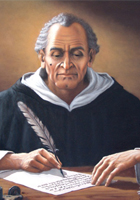Tommaso Campanella
Tommaso Campanella Poems
THE PEOPLE is a beast of muddy brain
That knows not its own strength, and therefore stands
Loaded with wood and stone; the powerless hands
...
Tommaso Campanella Biography
Tommaso Campanella OP (5 September 1568 – 21 May 1639), baptized Giovanni Domenico Campanella, was a Dominican friar, Italian philosopher, theologian, astrologer, and poet. Born in Stignano (in the county of Stilo) in the province of Reggio di Calabria in Calabria, southern Italy, Campanella was a child prodigy. Son of a poor and illiterate cobbler, he entered the Dominican Order before the age of fourteen, taking the name of fra' Tommaso in honour of Thomas Aquinas. He studied theology and philosophy with several masters. Early on, he became disenchanted with the Aristotelian orthodoxy and attracted by the empiricism of Bernardino Telesio (1509–1588), who taught that knowledge is sensation and that all things in nature possess sensation. Campanella wrote his first work, Philosophia sensibus demonstrata ("Philosophy demonstrated by the senses"), published in 1592, in defence of Telesio. In 1590 he was in Naples where he was initiated in astrology; astrological speculations would become a constant feature in his writings. Campanella's heterodox views, especially his opposition to the authority of Aristotle, brought him into conflict with the ecclesiastical authorities. Denounced to the Inquisition, he was arrested in Padua in 1594 and cited before the Holy Office in Rome, he was confined in a convent until 1597. After his liberation, Campanella returned to Calabria, where he was accused of leading a conspiracy against the Spanish rule in his hometown of Stilo. Campanella's aim was to establish a society based on the community of goods and wives, for on the basis of the prophecies of Joachim of Fiore and his own astrological observations, he foresaw the advent of the Age of the Spirit in the year 1600. Betrayed by two of his fellow conspirators, he was captured and incarcerated in Naples, where he was tortured on the rack. He made a full confession and would have been put to death if he had not feigned madness and set his cell on fire. He was tortured further (a total of seven times) and then, crippled and ill, was sentenced to life imprisonment. Metaphysica, 1638 Campanella spent twenty-seven years imprisoned in Naples, in various fortresses. During his detention, he wrote his most important works: The Monarchy of Spain (1600), Political Aphorisms (1601), Atheismus triumphatus (Atheism Conquered, 1605–1607), Quod reminiscetur (1606?), Metaphysica (1609–1623), Theologia (1613–1624), and his most famous work, The City of the Sun (originally written in Italian in 1602; published in Latin in Frankfurt (1623) and later in Paris (1638).)
The Best Poem Of Tommaso Campanella
The People
THE PEOPLE is a beast of muddy brain
That knows not its own strength, and therefore stands
Loaded with wood and stone; the powerless hands
Of a mere child guide it with bit and rein;
One kick would be enough to break the chain,
But the beast fears, and what the child demands
It does; nor its own terror understands,
Confused and stupefied by bugbears vain.
Most wonderful! With its own hand it ties
And gags itself—gives itself death and war
For pence doled out by kings from its own store.
Its own are all things between earth and heaven;
But this it knows not; and if one arise
To tell this truth, it kills him unforgiven.
